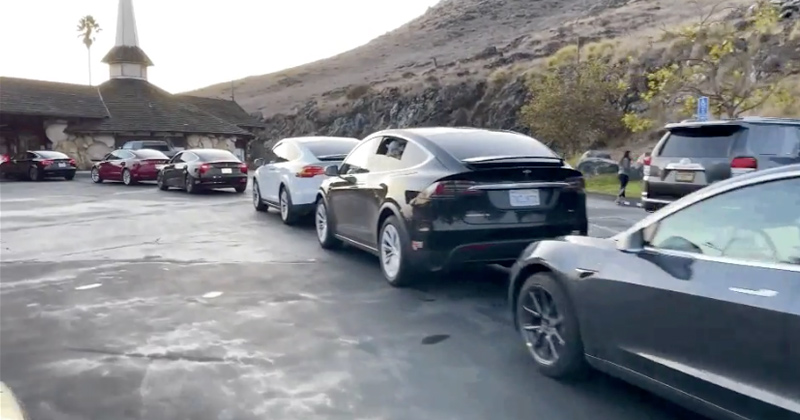Folks, I know I keep harping on Elon Musk and the utopian dream of all electric homes, cars, and life in general but as Clint Eastwood once famously said in one of his many Dirty Harry movies, “A man’s got to know his limitations.”
Now
Tesla has hardly any market penetration in the United States but is gaining in popularity in California but not without consequences. As I keep saying, charging these cars is a big deal. Look at the ridiculous lines over the Thanksgiving vacation just to keep Elon’s fleet on the road. Drivers waited up to an hour to get to a charger and then a decent charge takes 45 minutes.
Footage out of Kettleman City, the location of one of the largest supercharging sites boasting up to 40 chargers, shows drivers queued up back-to-back in a line about a half mile long.
Video: Tesla Drivers Wait Up to an Hour to Charge Electric Vehicles
Testy drivers attempting to juice up after Black Friday sounded off on social media, claiming the wait time was anywhere from thirty minutes to well over an hour.
In a few years…
Predictions of the future are worse. If 10 percent of California households owned a Tesla and try to charge them overnight, the resulting electric demand would crash the electric grid and that’s assuming PG&E and Southern Cal Edison are maintaining their gear.
As we have previously documented on this blog, given current rates of worldwide mineral production and demand, Great Britain cannot achieve its goal of an all-electric fleet of vehicles by 2040—this calculation is assuming that nobody else in the world like maybe California is simultaneously trying to do the same thing.
Long-term
Worse yet, another battery (pun intended) of reports has even more dire warnings about our dependence on technology. At current rates of production, six vital minerals used in high tech devices like self-driving cars and smartphones will be gone within 100 years.
Besides the raw waste, mobile devices contain “conflict elements” like gold, toxic elements such as arsenic and rare elements like indium, the Royal Society of Chemistry said. “Natural sources of six of the elements found in mobile phones are set to run out within the next 100 years,” it added.
Electronic waste pileup sparks warnings
Another concern over the recycling of unused devices is that they often contain what are known as “conflict elements” such as tin, gold, tungsten and tantalum, which are mined in areas where battles and child labour are often a routine part of their mining.
40 million unused gadgets in UK homes

“There are about 30 different elements just in a smartphone,” said Elisabeth Ratcliffe from the Royal Society of Chemistry, “and many of them are very rare.”
The metal indium, she explained, is used in a unique compound called indium tin oxide, which is vital for touch screens, because it conducts electricity and is transparent. “It’s also used in solar panels, so we’re going to need a lot of it in the future.
“There’s not a lot of it in the Earth and you need a kilo of ore to extract just a few milligrams of indium.”
Most of us will not have heard of tantalum, but it’s a highly corrosion-resistant metal that is “perfect for small electronic devices like our phones”, explained Ms Ratcliffe. “But it’s also perfect for hearing aids and pace-makers,” she told BBC News.
Scientists estimate that indium and tantalum mines, among others, could run out within a century. Meanwhile, our demand for new technology continues to increase.
“Even the copper in all that wire is not endlessly abundant,” added Ms Ratcliffe.
Elements in smart phones that could run out within the next 100 years
Millions of old gadgets ‘stockpiled in drawers’
- Gallium: Used in medical thermometers, LEDs, solar panels, telescopes and has possible anti-cancer properties;
- Arsenic: Used in fireworks, as a wood preserver;
- Silver: Used in mirrors, reactive lenses that darken in sunlight, antibacterial clothing and gloves for use with touch-screens;
- Indium: Used in transistors, microchips, fire-sprinkler systems, as a coating for ball-bearings in Formula One cars and solar panels;
- Yttrium: Used in white LED lights, camera lenses and can be used to treat some cancers;
- Tantalum: Used in surgical implants, electrodes for neon lights, turbine blades, rocket nozzles and nose caps for supersonic aircraft, hearing aids and pacemakers.
Before this series of articles, I’d never heard the term “conflict elements.” I guess folks were successful with turning “conflict diamonds” into “blood diamonds” so I guess now we can call things “blood Teslas” or “blood iPhones” or “blood solar panels”, the possibilities are seemingly endless. Oh, and child/slave labor also gets a shout-out in these articles too.
Conclusion
It seems that Liberals are torn between telling you to recycle your old gizmos and guilt tripping folks that love technology. Maybe they’ll try doing both. Folks look for this pending shortage to be a way to raise even more taxes on recycling when you buy new stuff—even if it really ends up in the landfill. And if the predictions start to pan-out as being true, look for Elon Musk to propose mining asteroids, the Moon, or some other astronomical body to keep our stuff in production.
Bottom-line: Government planners and technology manufacturers seem to be on a collision course with reality. Mineral production is far less than long term demand and nothing will change that anytime soon.
Lastly, look for this as a future way to weaponize a movement against technology for the masses.


